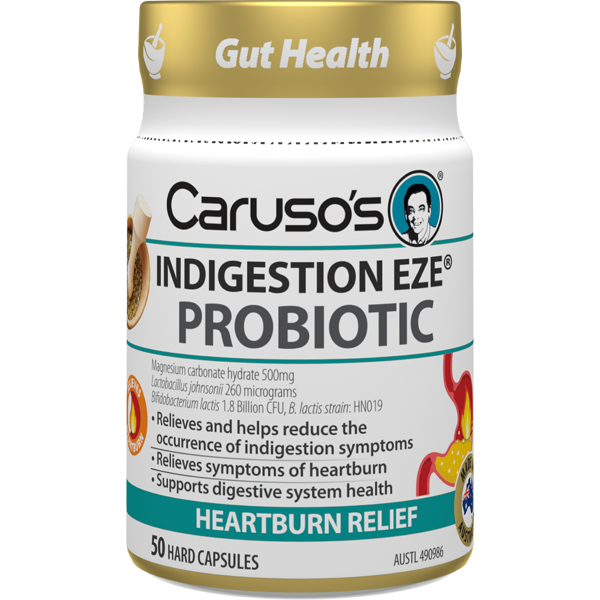
Indigestion Unpacked: Causes, Triggers and How to Get Relief
share
The food we eat provides our bodies with the nutrients they need to carry out everyday functions. It is also a large part of our lives socially and culturally, whether we are catching up with friends for lunch or getting together with family to celebrate – food fuels our bodies and brings us together.
For some people, eating can be like Russian roulette for their digestion. The constant worry of whether their daily coffee on an empty stomach or the burger and hot chips for lunch will result in indigestion lasting anywhere from minutes to hours after eating.
What is Indigestion?
Dyspepsia is the medical term for indigestion, or more simply known as an upset stomach. Indigestion can be described as a sensation of discomfort and/or a burning pain in the upper middle abdominal area, often occurring during or after eating. 1,2
An additional symptom of indigestion is a burning sensation in the chest called heartburn. This is caused by stomach acids irritating the mucosal lining and escaping to the oesophagus from the stomach. 1,2,3
Causes of Indigestion
Indigestion is often triggered by the process of eating, whether that be over-eating, eating too quickly, food intolerances, or certain foods that may be rich, fatty, spicy, or acidic. Other triggers can include the consumption of caffeine, alcohol, and carbonated beverages, smoking tobacco, certain medications, or stress. The recurrence of symptoms around meal times can be easy to explain, however if this becomes more frequent and occurs long-term, it may be associated with other underlying conditions that may be affecting the digestive system, which should always be medically addressed. 1,2,3
Heartburn – A Symptom of Indigestion
Heartburn is often confused with indigestion – however, the two are not the same, and heartburn can appear as a symptom of indigestion. Heartburn is a painful, burning feeling that takes place in the middle of the chest and may radiate to the throat and/or back. Heartburn occurs during or after eating, can be accompanied by a sour or bitter taste in the mouth and throat, and tends to be worse when lying down. Heartburn is caused by the reflux of gastric acid, when the contents of the stomach (a combination of acid, enzymes, digestive juices, and food consumed) flow back up into the oesophagus, through the lower oesophageal sphincter as seen in Figure 1. 4,5
Figure 1

Heartburn The Link Between Digestive Health and Indigestion
The human gastrointestinal tract contains a dynamic and intricate population of microorganisms. It serves as one of the largest interfaces between the host and external environmental factors, as well as antigens in the body. Approximately 100 trillion microorganisms exist in the human GI tract. 6,7
Probiotics help to maintain beneficial intestinal flora, supporting both digestive and gastrointestinal system health. The health of the gastrointestinal system can have a significant impact on gastrointestinal functioning, and symptoms such as heartburn may occur in states of poor gut health due to an imbalance or disruption of the gut microbiota, known as dysbiosis. This highlights the importance of maintaining intestinal beneficial flora when supporting gastrointestinal health and function. 8,9
Postbiotics are inactive microorganisms and have been gaining a lot of attention over recent years. Due to them being inactive they have a long shelf life and can contribute to the health of the individual by improving specific physiological functions. 10
Magnesium Carbonate for Indigestion and Heartburn
Magnesium carbonate (the common name of magnesium carbonate hydrate) is a form of magnesium that is well known for its effects on relieving indigestion. As mentioned above, the burning sensation related to indigestion is due to stomach acids irritating the mucosal lining and escaping to the oesophagus. Magnesium carbonate works by neutralising the acids in the stomach. When it comes into contact with gastric hydrochloric acid, it reacts and forms magnesium chloride, water, and carbon dioxide. This results in relief of symptoms of heartburn and indigestion. 11,12
Caruso’s Indigestion EZE® Probiotic
Caruso’s Indigestion EZE® Probiotic contains magnesium carbonate, Bifidobacterium Lactis (HN019), a probiotic, and Lactobacillus Johnsonii (LJ 1088), a postbiotic. Magnesium carbonate plays an important role in this formulation to relieve symptoms of heartburn and help reduce the occurrence of symptoms of indigestion. It is paired with a probiotic to support healthy gastrointestinal function and gastrointestinal system health and maintain intestinal beneficial flora. Caruso’s Indigestion EZE® offers a comprehensive solution to support digestive system health while helping reduce symptom of indigestion and heartburn.
Always read the label and follow the directions for use.
References
- National Institute of Diabetes and Digestive and Kidney Diseases. (2025). Definition & facts for indigestion (dyspepsia). U.S. Department of Health and Human Services, National Institutes of Health. https://www.niddk.nih.gov/health-information/digestive-diseases/indigestion-dyspepsia/definition-facts
- Cleveland Clinic. (2022). Indigestion (dyspepsia). https://my.clevelandclinic.org/health/symptoms/7316-indigestion-dyspepsia
- Talley, N. J., Ford, A. C., & Walker, M. M. (2015). Functional dyspepsia. Gastroenterology &Hepatology, 16(2), 67–76. https://doi.org/10.1007/s00535-021-01843-7 (Original work published2015) Retrieved from https://www.ncbi.nlm.nih.gov/pmc/articles/PMC4015195/
- WebMD Editorial Contributors. (2024, January). Indigestion (dyspepsia): Symptoms, causes, and treatments. WebMD. https://www.webmd.com/heartburn-gerd/indigestion-overview
- Healthdirect Australia. (2023, October). Heartburn. Healthdirect. https://www.healthdirect.gov.au/heartburn 7. myDr. (n.d.). Gastro‑oesophageal reflux disease.https://mydr.com.au/gastrointestinal-health/gastro-oesophageal-reflux-disease/
- Valdes, A. M., Walter, J., Segal, E., & Spector, T. (2018). Role of the gut microbiota in nutrition and health. Science and Politics of Nutrition, 361. https://doi.org/10.1136/bmj.k2179
- Thursby, E., & Juge, N. (2017). Introduction to the human gut microbiota. The Biochemical Journal, 474(11), 1823–1836. https://doi.org/10.1042/BCJ20160510
- Health Canada. (1996). Antacids: Labelling standard [PDF]. Health Canada. https://www.canada.ca/content/dam/hc-sc/migration/hc-sc/dhp-mps/alt_formats/hpfb-dgpsa/pdf/prodpharma/antacid_antiacid-eng.pdf
- Healthdirect Australia. (2024, March). Gut health – prebiotics, foods, microbiome. HealthdirectAustralia. https://www.healthdirect.gov.au/gut-health
- Aguilar-Toalá, J. E., Garcia-Varela, R., Garcia, H. S., Mata-Haro, V., González-Córdova, A. F.,Vallejo-Cordoba, B., & Hernández-Mendoza, A. (2023). Postbiotics: An overview of concepts,inactivation technologies, health effects, and driver trends. Trends in Food Science &Technology, 138, 199–214. https://doi.org/10.1016/j.tifs.2023.06.009
- Zhou, L., Zeng, Y., Zhang, H., & Ma, Y. (2022). The role of gastrointestinal microbiota infunctional dyspepsia: A review. Frontiers in Physiology, 13, Article 910568.https://doi.org/10.3389/fphys.2022.9105681
- Garg, V., Narang, P., & Taneja, R. (2022). Antacids revisited: Review on contemporary factsand relevance for self-management. Journal of International Medical Research, 50(3).https://doi.org/10.1177/03000605221086457
Try it now

Caruso's Indigestion EZE® Probiotic
share
Stay Informed. Feel Your Best.
Get expert tips and actionable health advice. Be the first to hear about Caruso's product launches and receive exclusive promotional offers.
Join our newsletter today.



